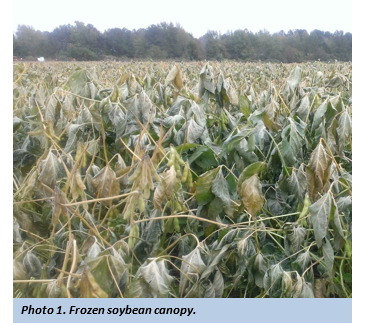Evaluating Frost Damage in Soybean
From Crop & Pest Report - (09/10/20)
Soybean leaves on the top of the canopy are easily damaged by frost in the 30 °F to 32 °F range.

Soybean leaves on the top of the canopy are easily damaged by frost in the 30 °F to 32 °F range (Photo 1). Temperatures lower than 30 °F, for any extended period, can kill soybean plants (stems and leaves).
Soybean fields planted to narrow row spacing (6 to 15 inch) may have slightly more tolerance to light frosts compared to soybeans planted in wider rows (30 inch). In addition, soybean fields with thin stands are more affected and injured by frost, compared to fields with normal plant populations.
The thick plant canopy of solid-seeded or closely drilled beans tends to hold the soil heat better and protects the lower portion of the plants and developing pods to some degree. Pods in the lower portion of the plant should continue to fill beans and develop normally. Frost injury can also delay soybean maturity. Frost damage can cause some small pods in the upper area of the plants to not fill normally and they can abort in some cases. With a killing frost, beans in the pods that are still green and soft will shrivel. Stems rapidly turn from dark green to brown and will not recover. Beans in pods that have turned yellow will mature normally.
To investigate potential frost damage, it is necessary to assess soybean pod maturity. Yellow pods sprinkled with brown are an indication that the crop is close to physiological maturity. It is suggested to open pods and check shrinking of beans and look for separation of beans from the white membrane inside the pod. This indicates the soybeans are physiological mature and safe from frost injury. However, not all pods mature evenly. When one or two pods on any of the upper four nodes have turned completely brown in color and other pods are light yellow to tan, the soybeans should be reasonably tolerant to a killing frost.

Research information from Wisconsin indicated that all varieties tested had reduced yields when frost occurred at or before R6 (full seed). The greatest yield losses occurred when frost occurred at stage R5 (beginning of seed development). The number of beans per plant and reduced bean size all contributed to overall yield loss. A frost between R6 and R7 may or may not affect yield depending on the temperature and duration of the freeze. Table 1 shows growth stages and potential yield losses of a killing frost on soybeans.
The leaves do remain on the frost damaged soybean plants. Seed moisture may be slightly higher and seed size is usually reduced as the soybeans dry and shrink. A frost will not hurt soybean yields if the soybean growth stage is beyond R7.
Extension Agronomist Broadleaf Crops
This site is supported in part by the Crop Protection and Pest Management Program [grant no. 2017-70006-27144/accession 1013592] from the USDA National Institute of Food and Agriculture. Any opinions, findings, conclusions, or recommendations expressed are those of the website author(s) and do not necessarily reflect the view of the U.S. Department of Agriculture.
